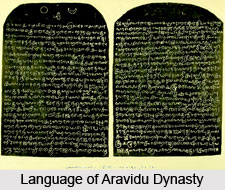 Reigning as the last and final dynasty of Vijayanagara Empire of South India, Aravidu Dynasty had contributed much to ancient Indian language and linguistics. Archaeologists after much excavation have triumphantly discovered over 7000 inscriptions called Shasana, including three hundred copper plate inscriptions called Tamarashasana. These priceless language structures have been recovered, approximately half of which are in Kannada. The remaining finds manifest to be in Telugu, Tamil and Sanskrit. It can thus be deduced that language during Aravidu dynasty had much to do with ancient Indian languages like mentioned in the above. Traces also speak that bilingual inscriptions had however lost errand by the 14th century. The realm were of the habit to mint coins at Hampi, Penugonda and Tirupati with Nagari, Kannada and Telugu legends hauling the archetypal name of the ruler. Gold, silver and copper were used to issue coins called Gadyana, Varaha, Pon, Pagoda, Pratapa, Pana, Kasu and Jital.
Reigning as the last and final dynasty of Vijayanagara Empire of South India, Aravidu Dynasty had contributed much to ancient Indian language and linguistics. Archaeologists after much excavation have triumphantly discovered over 7000 inscriptions called Shasana, including three hundred copper plate inscriptions called Tamarashasana. These priceless language structures have been recovered, approximately half of which are in Kannada. The remaining finds manifest to be in Telugu, Tamil and Sanskrit. It can thus be deduced that language during Aravidu dynasty had much to do with ancient Indian languages like mentioned in the above. Traces also speak that bilingual inscriptions had however lost errand by the 14th century. The realm were of the habit to mint coins at Hampi, Penugonda and Tirupati with Nagari, Kannada and Telugu legends hauling the archetypal name of the ruler. Gold, silver and copper were used to issue coins called Gadyana, Varaha, Pon, Pagoda, Pratapa, Pana, Kasu and Jital.
Style of language of Aravidu dynasty had a significant impact upon their mintage, which impressed a lasting image in almost every domain in life. The coins enclosed the images of various Gods, including Balakrishna (infant Krishna), Venkateshwara (the presiding divinity of the temple at Tirupati), Goddesses such as Bhudevi and Sridevi, heavenly couples, animals such as bulls and elephants and birds. The original coins were also attributed to Hanuman and Garuda (divine eagle), the vehicle of Lord Vishnu. Kannada and Telugu inscriptions belonging to Aravidu dynasty have been deciphered and recorded by historians from the Archaeological Survey of India.
The Emperors of Vijayanagara (of which Arvavidu Dynasty is an inseparable realm) addressed themselves deliberately to the task of preserving the Hindu social and political order from being destroyed by Islam. In fact, contemporary humankind is much enlightened that incessant Islamic invasions had, to a profound extent, substantially destroyed and plundered rise of Hindu inscriptions, scriptures or even daily order. Although, in this particular instance concerning language usage of Aravidu dynasty, they had, in the process, been exceedingly successful in spite of repeated reverses in the battlefield. The South Indian society currently represents a striking contrast in several respects to North Indian society, in that South India is still adorned by a large number of great temples that enshrine the artistic accomplishments of successive generations of Hindu master-builders. These temples further have been embellished with meticulous and fancy scriptures and writings, wholly re-drawing the ancient lines in Aravidu dynasty. The Hindu-Muslim troubles and hostilities were virtually though unknown in the South, furnishing specific measures of success that attended to the efforts of Vijayanagara and its rulers.



















